 Breaking stories, developing crises, and unexpected catastrophes often involve more than one country, community, and culture. As our children listen in to the radio while stuck in traffic or the evening news program over dinner, it can be easy to think that if we don’t explicitly bring up the news story, then our children don’t know it’s happening.
Breaking stories, developing crises, and unexpected catastrophes often involve more than one country, community, and culture. As our children listen in to the radio while stuck in traffic or the evening news program over dinner, it can be easy to think that if we don’t explicitly bring up the news story, then our children don’t know it’s happening.
In fact, children are incredibly perceptive when their parents and adults close to them are distracted by news or alarming events. Many children also pick up information from their peers.
While we don’t want to overwhelm or scare our children, it is important to discuss what is going on. Children need honest portrayals of a community at its best during a time we might be seeing it at its worst.
How do we talk to children about these events and use these moments as opportunities to have respectful, honest (albeit age-appropriate) discussions?
Picture books are invaluable conversation starters. Conflicts and disasters have complex origins and multiple players. Issues of race, class, religion, and gender are often entangled in the events or portrayal of the events. Children’s books dealing with conflict or natural disasters can frame the event in contexts and meanings suitable to their developmental stage. Stories with children as the main characters allow children to identify with the characters over universal themes.
When a “newsworthy” event happens, this may be the first time the child learns of this country, group of people, or culture. By the same token, the conflict or event may involve the child’s own heritage or culture. Using picture books to talk about a current event or conflict can be an opportunity to learn about a new region and help children see the culture and people beyond this event.
Instead of allowing the media to define the group of people involved, we should seek out and read a book showcasing and reinforcing the positive aspects and pride of the featured group of people and region. In doing so, we present a broader perspective of the community, culture, or people that media coverage is portraying in a negative, humiliating, or victimized light.
In selecting the right book to foster respect and provide an honest portrait of a community in the news, consider:
 Books that champion human dignity:
Books that champion human dignity:
- First Come the Zebra
- Dear Mrs. Rosa Parks: A Dialogue with Today’s Youth
- I and I Bob Marley
- Passage to Freedom: The Sugihara Story
Books that exhibit the strength, courage, and resilience of children:
- When the Horses Ride By: Children in the Times of War
- Brothers In Hope: The Story of the Lost Boys of Sudan
- Baseball Saved Us
- A Song for Cambodia
Books that depict a community’s capacity to endure, love, and give:
- Sharing Our Homeland: Palestinian and Jewish Children at Summer Peace Camp
- Dia’s Story Cloth: The Hmong People’s Journey of Freedom
- Coming to America: A Muslim Family’s Story
“Age-appropriate” can mean truthful, thoughtful conversations. When talking to children, let them guide the discussion. Opening conversation starters include:
- What questions do you have? What have you heard?
- What do you know about the situation or group of people/foreign country involved?
- Who are the countries or communities involved?
- How are different communities and countries coming together over this issue?
- What would you like to do to help?
For further reading:
- Talking to Children About Disasters from American Academy of Pediatrics
- Talking with Kids About News from PBS Parents
- Advice on talking to children about the Holocaust with Marcia Vaughan, author of Irena’s Jars of Secrets
- Book ideas for children about trauma, grief, and loss
- 50 Ways to Teach with Current Events (NYTimes)
- Three Teacher-Tested Ways to Encourage Your Students to Follow Current Events This School Year (NYTimes)
 Jill Eisenberg, our Resident Literacy Expert, began her career teaching English as a Foreign Language to second through sixth graders in Yilan, Taiwan as a Fulbright Fellow. She went on to become a literacy teacher for third grade in San Jose, CA as a Teach for America corps member. She is certified in Project Glad instruction to promote English language acquisition and academic achievement. In her column she offers teaching and literacy tips for educators.
Jill Eisenberg, our Resident Literacy Expert, began her career teaching English as a Foreign Language to second through sixth graders in Yilan, Taiwan as a Fulbright Fellow. She went on to become a literacy teacher for third grade in San Jose, CA as a Teach for America corps member. She is certified in Project Glad instruction to promote English language acquisition and academic achievement. In her column she offers teaching and literacy tips for educators.









